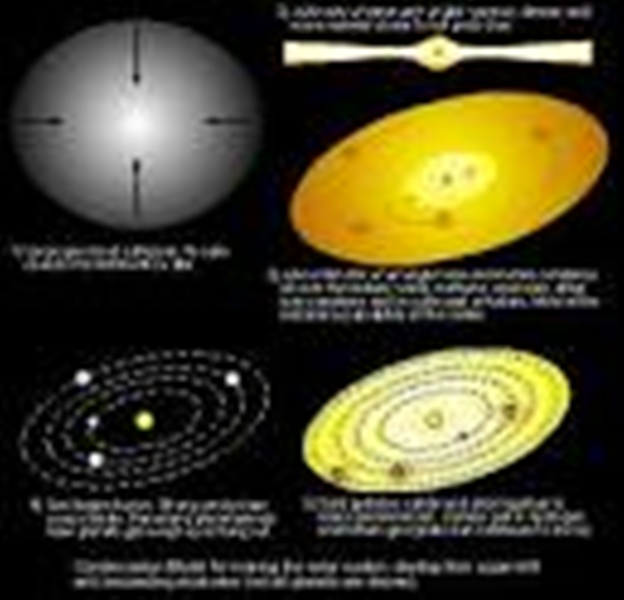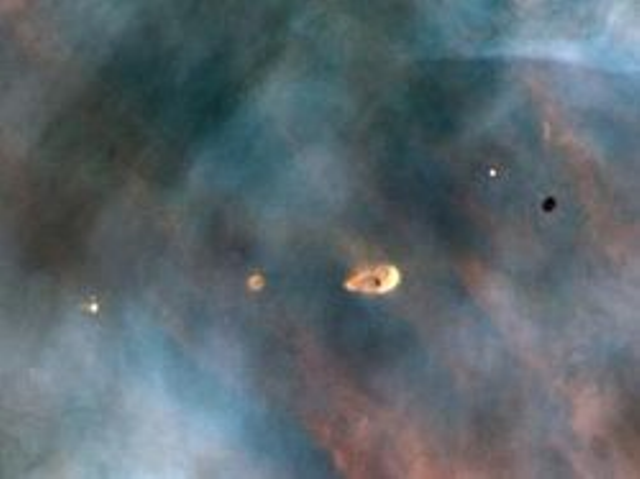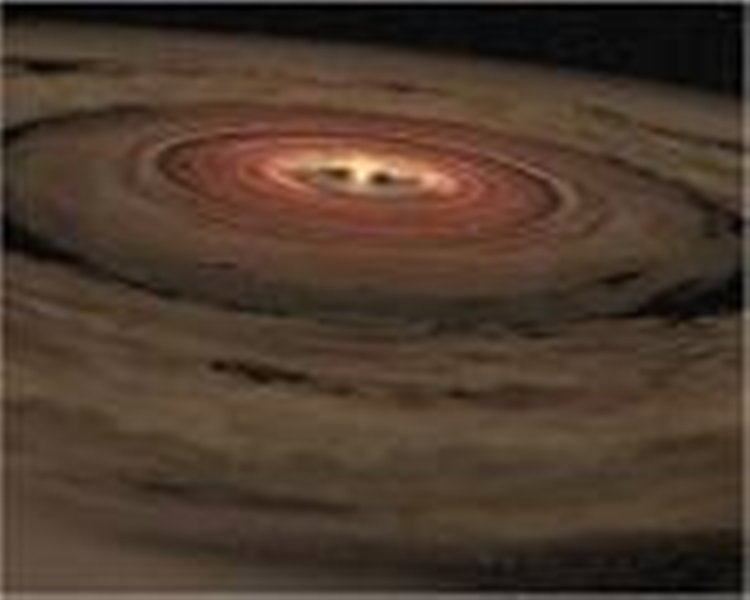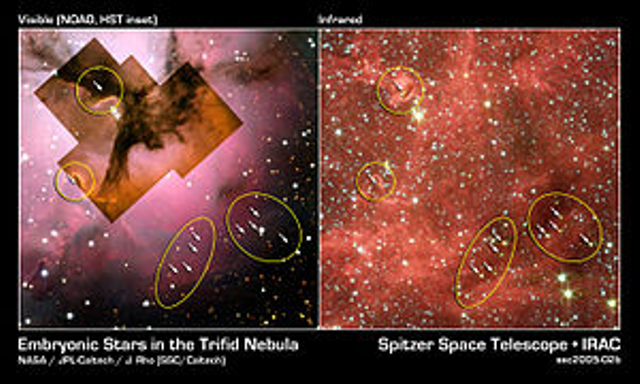Introduction
Philosophers and scientists, particularly the astronomers, have been looking for information pertaining to how the universe was formed.
Even though there is no single authoritative model that explains the manner in which the universe was formed, there is one model that satisfies the highest share of astronomers: the nebular hypothesis or model.
The model is not only the most popular but also the one that garners several factual arguments on its accounts for the formation of the universe. The hypothesis dates back to 1734 when Emanuel Swedenborg (Woolfson 1984, p.6) first proposed it.
It dates the formation of the universe back since some 4.6 billion years following the collapse of an interstellar molecular cloud of particles comprising of ice, rock, and dust among others. However, several criticisms were raised on it for a couple of years making it fall out of favour.
One of the central criticisms of the nebular hypothesis rested on its inability to provide an explanation on why the sun lacked angular momentum in comparison with all other planets, which orbit around it (Fogg & Nelson 2007, p.1195). Nevertheless, “now, it is back with a definitive model” (Gomes et al. 2005, p.466).
As from early 1980s, tremendous studies have been carried on young stars. The studies show that young stars are “surrounded by cool discs and gas, exactly as the nebular hypothesis predicts” (Gomes et al. 2005, p.468). This has made the nebular hypothesis to be reaccepted.
Following this validation of nebular hypothesis, this paper finds it ample to describe nebular model of the solar system coupled with the features of solar system that the model explains.
Description of Nebular model of the solar system
According to nebular model of the formation of the universe, the formation of the solar system is inherent to the formation of the stars and planetary disks. The figure below shows fundamentals of universe formation.

Source: (Kokubo & Ida 2002, p.673)
Formation of stars
Stars are believed to have been formed from a giant cloud of molecular hydrogen, which was as big as 300,000 times the size of the sun (Montmerle at al. 2006, p.42). The nebular theory of the solar system approximates that the massive collapsing of the proto-stellar nebulae took place some 100, 000 years ago (Pudritz 2002, p.69).
All nebulas initiate with some angular momentum. A gas is found at the centre of every nebular. Relative to the outer parts, this gas has a lower angular momentum. It undergoes an incredible compression resulting to the formation of a hot core that does not contract.
The core’s mass is lesser than the original mass of the entire nebula (Mohanty, Ray & Basri 2005, p.492). The core constitutes the seed, which, while fully grown, forms the stars. Further collapsing truncates into retention of the angular momentum.
Consequently, “the rotation of the in-falling envelop accelerates which largely prevents the gas from directly accreting onto the central core” (Klahr & Bodenheimer, 2003, p.869). Forcefully, the gas finds its way outwards close to “the equatorial plane of the core, which in turn forms the disk that further accretes onto the formed core” (Klahr & Bodenheimer 2003, p.887).
This makes the core grow magnificently in terms of mass to the extent that it makes up a proto-star, which is very hot. In this particular stage, the in-falling envelope gigantically obscures the proto-star coupled with its disk making it directly invisible (Mohanty, Ray & Basri 2005, p.499).
The proto-star emits a radiation, which is in the order of sub-millimeters or millimeters. Nebular theory classifies these proto-stars as belonging to class zero. However, the luminosity of these proto-stars is ideally very high ranging in the order of 100.
This energy originates from gravitational collapses (Kokubo & Ida 2002, p.666). It occurs because the cores of the proto-stars have not become hot enough to the extent that the process of nuclear fusion can begin.
When the materials forming the envelope proceed falling into the proto-star disk, a stellar object becomes conspicuous. This occurs initially in the region of infrared and in a visible range of electromagnetic spectrum later.
When the proto-star garners enough mass above, about 80 times of that of Jupiter, hydrogen fusion initiates. However, when this mass is lower than this, a brown dwarf object is developed (Mohanty Ray & Basri 2005, p.508).
Development of new stars takes place about 100, 000 years upon inception of the collapse process. The resulting solar system’s objects are classified as class one proto-stars at this level.
During the next stage, the disk gathers the envelope. This results to its disappearance. The resulting proto-star is the T Tauri star. According to Mohanty, Ray and Basri (2005), “the mass of the disk around a classical T Tauri star is about 1–3% of the stellar mass, and it is accreted at a rate of 10-7 to 10-9 solar masses per year” (p.505).
A classical T Tauri star has properties such as “emission limes, existence of jets, photometric variability, strong flux, and possession of magnetic activities” (Mohanty, Ray & Basri 2005, p.505).
The formation of the emission lines is owed to the hitting of the star’s surface by accreted gas. This takes place within the magnetic poles. The jets are principally the avenues through which the excessive momentum of the star is lost.
Formation of planetary disks and planetary system
Apart from the formation of stars, another essential concern of the nebular model is to provide an explanation of how the proto-planetary disks are formed. This provides mechanisms of laying the foundation on provision of an explanation on how the entire universe formed, as well as how it continuously evolves.
Nebular hypothesis holds that, under certain circumstances and provisions, instead of disappearance of the planetary disk, it may give rise into a planetary system.
Megeath et al. supports this argument by claiming, “Proto-planetary disks have been observed around a very high fraction of stars in young star clusters” (2005, p.114). An example of formation of a proto-planetary disk in Orion nebula is shown in the figure below.

Source: (Font et al. 2004, p.901)
Disks exist right from the onset of the process of formation of stars. However, in the early stages, it is not possible to view them because of opacity in the environment that surrounds a proto-star. For a class zero proto-star, the planetary disk is immensely hot.
Consequently, inside the disk, many of the volatile materials evaporate leaving behind refractory elements. Therefore, ice can only possibly exist in the outermost part of the disk (Font et al 2004, p.901). Rocky planets are formed in the inner sections of the proto-planetary disks.
In these sections, temperatures are too high to permit condensation of ice coupled with certain other substances to form grains (Sean, Quinn & Lunine 2007, p.67). Consequently, coagulation of grains that are rocky in nature occur leading to creation of planetensimals that are rocky.
In the words of Montmerle et al (2006), the conditions “are thought to exist in the inner 3-4 AU part of the disk of a sun-like star” (p.73). On the formation of the planetensimals from the proto-planetary disks, the process of runaway accretion initiates.
During this process, the planetary body grows such that M4/3 is directly proportional to R4 (Montmerle et al 2006, p.65) where R is the radius of the growing body while M is its mass. When this process is completed, the stages of oligarchic accretion and merger follow respectively. These are the last two stages for the formation of a rocky planet.
Features of solar system explained by nebular solar system
The nebular theory for the formation of the solar system explains the process of formation of a number of features that make up the solar system. They include stars, planets, and asteroids among others.
The theory holds that the universe formed when the interstellar gas molecules that were filled with ice, rocks, and dusts among other particles spontaneously collapsed. This collapse was caused by a turbulence whose aftermath was heating up of these particles making them turn into stars.
Initially, the components that make up the universe were in the form of clouds. A cloud of dust believed to form the solar system by astronomers is shown below.

Source: (Montmerle et al 2006, p.47)
During the solar system formation process, most of these clouds settled at the centre to form the sun. On the other hand, some of the materials became flattened to form the planetary disks (Montmerle et al 2006, p.49). Material making up the disks formed the planet coupled with other objects that are found in the solar system.
Other materials stuck together to form solids (balls), which grew bigger when more materials collided with them. The balls formed the cores of the planets.
When the growing solids developed their own gravitational pulls, the rate of attraction of ice and dusts particles became even more enhanced.
Stars and terrestrial planets
With regard to the nebular hypothesis, stars resulted from the thick and gigantic particles of hydrogen vapours.
The hydrogen clouds were “gravitationally unstable and matter coalesced to smaller denser clump, which then collapsed and formed stars” (Stamatellos, Hubber & Whitworth 2007, p.31). The formation of giant stars is illustrated below.

Source: (Stamatellos, Hubber & Whitworth 2007, p.30)
The nebular hypothesis also holds that the process of star formation is an intricate one. It produces hefty amounts of proto-planetary disks of gasses around a forming star. In the due process, this may truncate into the formation of planets.
Consequently, the procedure of star creation results to the innate configuration of terrestrial system. In this context, Fogg and Nelson (2007) claim that the hypothesis approximates, “…a sun-like star usually takes 100 million years to form” (p.1198). The proto-planetary disks are initially hot.
However, during the T Tauri star formation stage, it cools down upon attracting more dust grains that are composed of ice and rocks. This makes the first stage of formation of the planetary system. The second stage is marked by the coagulation of planentesimals to become kilometer-sized embryos right from centimeter-sized ones.
However, “ if the disk is massive enough, the runaway accretions begin, resulting in the rapid-100,000 to 300,000 years- formation of moon-to mars-sized planetary embryos”(Sean, Quinn, T & Lunine 2007, p.70).
Within the vicinities of stars, the developing embryos of planets undergo massive merging processes leading to the formation for terrestrial planets.
This is the last stage, which takes approximately 100 million years. The most complex development is that of the creation of colossal planets like Jupiter.
Giant planets
Formation of Giant planets is thought to take place under conditions that are below snowlines. In such situations, the emanating planets embryos are principally comprised of ices. Consequently, such planets are “several times massive than the inner part of the proto-planetary disks” (Fogg & Nelson 2007, p.1196).
The nebular hypothesis further postulates that the components that are formed after the formation of the ice embryo are necessary. This remains unclear even though growth may take place to surpass 5 to 10 times the size of the earth.
This threshold value is critical in the initiation of the process of accretion of gases (hydrogen-helium) from the surface of the disks. According to this theory, the course of gathering gases at the center of the springing planet is essentially slow.
However, “when the planet becomes 30 or more times greater than the earth, the process accelerates and extends into the runaway” (Montmerle et al 2006, p.41). The process of accretion does not proceed for eternity. It stops upon exhaustion of gasses. Consequently, planets acquire their defined masses since no further increase in masses occurs.
Planets already created may relocate themselves thus causing a failure of cores leading to the formation of planet-like Neptune and Uranus (Boss 2003, p.578). Cores leading to the formation of these two planets “were formed too late when the disk had almost disappeared” (Megeath et al 2005, p.113).
The nebular theory also holds that other components of the solar system were formed in similar manner in which the earth, the stars, and or giant planets such as Neptune, Saturn, and others were formed.
Asteroids
Just as Neptune was formed from failed cores, nebular theory claims that asteroids coupled with other planetesimals formed from failed formation of planets. Failed planets are essentially the objects that were formed from solar nebular (Bottke, et al. 2005, p.65).
However, they hardly ended up being large enough to compose a planet. From this explanation of the formation of asteroids, it is apparent that the initiation stages for formation of an element of the solar system may lead to the formation of another element under certain conditions such as the failure of a process to proceed to completion.
Conclusion
Many theories have been put forward to explain the formation of the solar system. One of such theories is the nebular theory of the formation of the solar system. The theory argues that the solar system was formed, and continues to evolve, through the coalescence of dust and ice among other particles in space.
The theory dates back to 1743 when Emanuel Swedenborg first put it forward. Although it later faced disfavours, the modern evidence based on studies of the formation of new stars has made its reaccepted. However, this does not mean that the theory has cleared up all its criticisms.
For instance, a prominent drawback of the theory rests on its inability to provide explanations of the manner in which materials that are accreted by proto-stars lose their angular momentum. Consequently, it becomes hard to explain why some stars possess planets while others do not have belts made of dust.
Amid these and other challenges of the nebular hypothesis, the paper has argued that the theory can explain the formation of some features of the solar system such as the stars, asteroids, and planets among others.
References
Boss, A 2003, ‘Rapid formation of outer giant planets by disk instability,’ The Astrophysical Journal, vol. 599 no. 1, pp 577–581.
Bottke, W, Durda, D, & Nesvorny, D 2005, ‘Linking the collisional history of the main asteroid belt to its dynamical excitation and depletion’, Icarus, vol. 179 no. 1, pp. 63–94.
Fogg, J & Nelson, P 2007, ‘On the formation of terrestrial planets in hot-Jupiter systems,’ Astronomy & Astrophysics, vol. 461 no.3, pp. 1195-1199.
Font, S, McCarthy, G, Doug, J, & Ballantyne, D 2004, ‘Photoevaporation of circumstellar disks around young stars,’ The Astrophysical Journal, vol. 607 no.2, pp. 890–903.
Gomes, R, Levison, F, Tsiganis, K & Morbidelli, A 2005, ‘Origin of the cataclysmic late heavy bombardment period of the terrestrial,’ Nature, vol. 435, no. 7041, pp. 466–469.
Klahr, H & Bodenheimer, P 2003, ‘Turbulence in accretion disks: vorticity generation and angular momentum transport via the global baroclinic instability,’ The Astrophysical Journal, vol. 582 no.2, pp. 869–892.
Kokubo, E & Ida, S 2002, ‘Formation of protoplanet systems and diversity of planetary systems,’ The Astrophysical Journal, vol.581 no.1, pp 666–680.
Megeath, T et al. 2005, ‘Spitzer/IRAC photometry of the ρ Chameleontis association,’ The Astrophysical Journal, vol. 634 no. 1, pp. 113-116.
Mohanty, S, Ray, J, & Basri, G 2005, ‘The T Tauri Phase down to Nearly Planetary Masses: Echelle Spectra of 82 Very Low Mass Stars and Brown Dwarfs,’ The Astrophysical Journal, vol. 626 no. 1, pp. 498–522.
Montmerle, T et al. 2006, ‘Solar System Formation and Early Evolution: the First 100 Million Years’, Earth, Moon, and Planets, vol. 98 no. 4, pp. 39–95.
Pudritz, R 2002, ‘Clustered star formation and origin of stellar masses,’ Science, vol. 295 no. 5552, pp. 68–75.
Sean, R, Quinn, T, & Lunine, J 2007, ‘High-resolution simulations of the final assembly of Earth-like planets 2: water delivery and planetary habitability,’ Astrobiology, vol. 7 no. 1, pp. 66–84.
Stamatellos, D, Hubber, A, & Whitworth, A 2007, ‘Brown dwarf formation by gravitational fragmentation of massive extended protostella discs,’ Monthly Notices of the Royal Astronomical Society: Letters, vol. 382 no. 1, pp. 30–34.